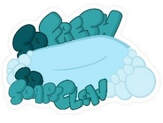
|
Community Day School (CDS), an alternative program in Oakland Unified School District is the proud home of the Wolverines and is dedicated to using a therapeutic and restorative justice-centered approach to give students a second opportunity to succeed in school. The campus empowers middle and high school students to build upon their strengths by supporting them academically, socially, and emotionally, through individual and small instruction, counseling, and career exploration.  As our students face a broad array of challenges in life, we work to help them understand how change is inevitable and how resiliency is a must. Regardless of the change being negative or positive, the Unconditional Education motto is vibrant at Community Day School. District and Seneca staff are working together to re-open campus and provide students with academic/technical support, meals, and a reliable space for them to find success. OUSD has provided each classroom with two air purifiers and personal protective equipment, and requires all members to complete a daily healthy screening before entering the learning hub. Here are just a few images of how our gorgeous campus is gradually transitioning back after a year of disarray.
0 Comments
“We all wear different hats here, formal and informal. Can you talk about the hats you wear in your community and what they mean to you?” This was a question my housemate asked someone applying to live in our cooperatively run house during their informal interview. It is a question I’ve been subliminally thinking about at work all year.  I’ve always worn different ‘hats’ as a Student Support Assistant (SSA). Our work weaves across the behavioral, socio-emotional, and academic realms depending on the students we are working with, what our school partners expect from us, and sometimes just depending on what kind of day it is. Yet I’ve found this to be especially pronounced during distance learning. At the dentist this week, the hygienist asked me what I do for a living, and I was tongue-tied for a moment. Last year I might have said something like, “I provide mental health and behavioral support for students at school,” because that felt like my primary role. Academics were often put on the backburner during support time with my kids because the behavioral, socio-emotional pot was boiling over. 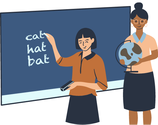 In distance learning, however, many SSAs are trying on the ‘teacher’ hat in new ways. One SSA said that last year she felt like a lot of her job was, “...a lot of crisis response and general in-the-moment behavioral redirections, incentive plans, tracking, and stuff like that,” whereas since distance learning, her work has shifted to encompass more of an academic support role focused on supplemental teaching. Some SSAs are also running reading intervention groups, or in my case, a community meeting every day for a group of sixth graders. School staff are spread thin, and as SSAs, we often flex and bend to fill in the gaps. With shortened class periods and long independent work blocks, there are a lot of academic gaps to fill.  Providing emotional support also looks different outside the often hectic school setting, with both potential for disengagement and intimacy. One SSA said she finds herself, “often feeling like a therapist” during her one-on-one Zoom check-ins with kids, with “a lot more kind of ‘talk therapy’ that comes up.” In the words of another SSA, “...we spend the most time with students, so we often have to switch out of different hats because we have to meet the different needs of the students throughout the day.” The need for emotional support has always been there, but the opportunities and needs for one-on-one check-ins with students have grown during this year of isolation. One SSA described our role as always wearing the hats of teacher, therapist, case manager, and behavioral coach rolled into one, and for her that hasn’t changed during distance learning. The main difference for her is that she is now finally accessing training on supporting students’ needs outside the behavioral realm: “For example, I had to dispense a lot of academic content without any training on how to teach math, ELA, etc. to students [last year].” This year, however, she had the opportunity to receive some training around supporting students with academic needs.  Sometimes I feel spread too thin as an SSA. Other times, I feel grateful that I get to be so many different versions of myself in one day. To a group of 12 sixth graders, I’m their community meeting teacher. To other kids, I’m the person who helps them with their schoolwork and organization skills. Then there is my 3rd grader who asked, “Wait, are you my therapist?” And I get to take the things I’ve learned in each of these roles and apply them to whatever situation I find myself in. It’s a balancing act that can be draining, and is not for everyone, but I find that grounding in the relationships I am building—despite whatever hat I’m wearing—keeps me from slipping. One year ago, schools shut down and shifted to the virtual setting. A year of Zoom calls, video meetings, phone chats, text messages, and emails. A year of challenges for our students, families, and us as educators. These challenges extended past our virtual schools to the real world. Through it all, I have seen the unbreakable human spirit. Love, compassion, hope, courage, respect, and curiosity. These Seneca core values appear innate to educators, and to me. They seem resilient to the adversity we face. They are truly unconditional. Our other core value, joy, seems to come and go. One moment it feels within my grasp, and the next, slipping through my fingers. 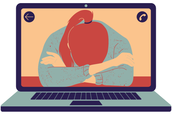 As the days have turned to weeks, the weeks turned to months, and the months into a year, I seek out this joy. The teachers I work with seek it too, but it can be hard to find amid a sea of black screens. Administrators and service providers want to find it as well, but it can be daunting in the digital divide. We aim to solve a myriad of new problems in school structures and the student experience. Our school looks for opportunities to dismantle white supremacy in the education system, and I grapple with how to be an ally. It’s my belief that to move forward in these pursuits, joy is essential. 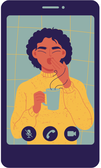 Seeking joy in times like this can be difficult. I admit in my work with students I’m quick to dive right into an algebraic equation or to discuss providing evidence for a topic sentence. An area of growth for me is connecting with students virtually. I miss greeting students in the morning, eating with them at lunch, and playing basketball with them in the afternoon. This is also true for my connections with coworkers. Instead of chatting over copies and coffee in the morning, or debriefing at the end of a class, we are face to face in an online meeting with little time to spare. When our school delved into the hard conversations of anti-racism, we could not come together in the following days and lift each other up. I am nostalgic for those organic moments of togetherness within a school day, when joy was not hard to find and I didn’t have to search hard for it.  Without those natural humanizing moments, I’ve attempted to be more intentional about joy. When I check in with students, we discuss what we’re enjoying in and out of school. In my meetings with teachers, we talk about lessons, activities, and how to improve outcomes for students. I then take time to ask teachers “What would make a lesson fun for you?” We tinker and collaborate on how to bring joy to the classroom for them, and for the students. In my digital interactions, I strive to carve out a few minutes of lightness and laughter.  As I sit reflecting upon this past year, a different perspective emerges. These fleeting joys I seek are the simple byproduct of in person human interaction, which I miss dearly. Having those moments can re-energize us as educators and motivate students to keep going. There is a tremendous amount of value in keeping our spirits high. It is important, but there’s also a deeper happiness to be found which can’t be sought after or created so easily. The true joys of Unconditional Education come from within the work itself. I recently had an IEP meeting with a freshman student. This student graduated 8th grade and started high school virtually, during a pandemic. I cannot imagine living through a pivotal time in such circumstances. The start of this school year was difficult for them, but this recent meeting felt more like a celebration. The student and their clinician were happy to report progress on a journey which enabled the student to recognize their thoughts and feelings, and to give them words. The team, the student, and their mother were thrilled to discuss the positive improvement in the student’s behavior. Their math teacher was ecstatic to discuss the student’s newfound confidence in solving problems step by step. The student and I made plans to tackle a new goal in self-advocacy, an area of challenge, but one that we are embracing in partnership.  This cheerful meeting was no happy accident. It took daily effort from the student, their mother, their teachers, support staff, and a team of service providers. Small moments of joy did sustain all of us in this work, but they can be conditional. They depend on the environment, the activity, and how we as people are connected to each other, which are all challenges in a pandemic. Rather, it is the loving, compassionate, hopeful, courageous, respectful, and curious moments we pour into education everyday which leads to meaningful joy. It is this joy that empowers a young person on their journey. It fills the heart of their family. It is why we persist as educators. A sustainable joy, unconditional. Seneca has always prided itself on providing Unconditional Care to children and families to assist them with various challenges and provide resources to thrive in daily living. However, let's be honest, this pandemic has made our usual roles even MORE challenging than before.  With the Unconditional Care model in mind, our team at Prescott Elementary and Seneca Oakland Alameda Public Schools (SOAPS) have actively brainstormed creative ways to engage families to ensure they receive adequate forms of support and resources no matter the circumstances. We’ve provided portable desks, academic supplies and posters to families to assist them in creating a designated space, within the home, where the student can access their education. To promote engagement, we’ve incorporated an incentive wheel in which students are surprised with incentives, at random times during instruction, when they display positive engagement. Some of the incentives include a 10-minute game break, homework pass, and extra picks at the student store or “grab bag”. We aim to provide a fun and structured environment for the students, while also holding them accountable with their expectations.  Bet you thought positive reinforcement just worked on students? Nope, it works with parents/caregivers as well. As a result, we’ve included families into student contracts and incentives so parents/caregivers can be included in the process. In addition, we’ve worked to communicate student improvements and successes, instead of challenges majority of the time, and to acknowledge family members for providing support because they deserve recognition as well. I hope I’ve been able to normalize the challenges we’ve all been facing and to provide ideas you may not have used yet or just inspire you to keep trying! We are all doing our best during this unprecedented time, so while we are providing love and compassion to our clients, don’t forget to love yourself as well. #SelfCare
The past 12 months have been rough for most people. While certainly not inherently worse, there have been unique challenges for those of us working as therapists. We have weathered the global COVID-19 pandemic and its associated personal, social, and political impacts right alongside the young people we work with and their families. 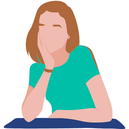 We have been isolated and overwhelmed, faced unthinkable loss both in our families and in our communities, as well as on a global scale, and we have been subjected to one political firestorm after another. On top of that we had to learn zoom. Many of us have risen with hope as part of the movement for Black lives -- and have also found ourselves heartbroken and exhausted as structural and interpersonal race-based violence continues to proliferate. Some of us did all of this with our children attending online school right beside us, never getting a break from being on duty or, conversely, in total isolation, without having the experience of in-person connection that usually fills us up and keeps us going. Our beautiful, flawed, resilient, and precarious human-ness has been on full display, and given the limitations of the COVID lifestyle, there’s not a lot we can do about that. It has affected each of us differently given our own identities, family structures, geographical and social locations. One thing is for certain: our common humanity is more pronounced than ever in our work. In learning to live with what is becoming ‘COVID normal,’ I sit with questions about what it means to be a therapist and balance my humanity with the service I am offering to others. Consider this illustration of a therapist’s office, with a 2020/2021 twist. Simply drawn, the room is immediately familiar: the classic therapy couch, chair, framed degrees on the wall, and a box of tissues on the table. But the therapist’s chair is empty, and both the therapist and client are on the couch, sitting close together, facial expressions somewhere in the vicinity of bewildered. The therapist’s pen and clipboard are strewn on the floor. This year more than ever, it may be true that we are ‘on the couch’ with our clients. As we live through so many tragedies and painful changes side by side, we are all simply doing our best with the tools we have at any given moment. There is healing in joining, and perhaps this joining is integral to the deconstruction of the western, white supremist ideologies that therapy as we know it was built on. These frameworks serve to maintain the veil of separation between therapist and client, upholding the false notion that one person in the room is an expert, and the other, a problem. 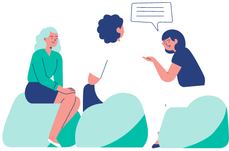 As therapists in training, we are taught about boundaries, professionalism, and keeping our selfhood out of the therapeutic relationship. Do not talk about yourself. You are a blank slate. Do not burden the client with your issues. Keep your messy humanity out of the work. Of course, this has value in terms of cultivating a space where the client can be the focus of the attention and receive necessary support, rather than be in a position of feeling beholden to the needs of the therapist. That being said, the antiquated notion of the therapist sitting in silence -- quietly diagnosing, holding knowledge and power, showing no vulnerabilities -- is deeply rooted in the othering that is inherent to the western and white supremist ideologies that the field of psychotherapy was built on. Going back to the illustration for a moment, it is important to note that both the therapist and client are white men.  In the drawing, to be even more specific, the therapist is wearing what appear to be Sigmund Freud’s signature glasses. I imagine this was an artistic choice made by the illustrator to indicate simply and clearly the who’s who of the scene, and it is effective. However, when taking into consideration the role that medical and scientific racism has played in the creation of therapy as we know it over the past 100 years or so, this is an opportunity to reflect on and shift out of the unspoken understanding that therapy is by and for white people. As a white therapist myself, looking at this from a decolonial or liberatory lens gives us a chance to consider the alternatives. By releasing ourselves as service providers from the western and white supremist ideologies of individualism, objectification, and hierarchical relationships (which Freud exemplified) we have an opportunity to participate in healing internally and in our therapeutic relationships. Dr. Eduardo Duran spoke on “Decolonizing Therapy and Healing the Soul Wound,” recently at the Compassion in Therapy Summit where he shared, “in a practice of therapy or a community intervention, if we bring in only a western approach, we are acting as colonizers, and basically imposing more trauma on the community,” causing more harm even as we operate with positive intentions toward healing. So how do we make this shift as individual humans who want to heal ourselves and be better therapists at the same time? One avenue for this will come from Seneca’s All-In Program’s upcoming 3 month long clinical training series with Dr. Jennifer Mullan, who is most widely known for her revolutionary Instagram account, @decolonizingtherapy. Through this medium as well as her role as a psychologist, consultant, trainer, and activist, her work has significantly contributed to the ongoing conversation around the importance of, as our training series is called, “Politicizing Your Practice.” By directly acknowledging our own intersecting identities in the therapeutic relationship, actively taking an anti-racist stance and striving to dismantle white supremacy in all its forms, accepting our areas of growth, releasing perfection as an ideal, and embracing the cultural and contextual knowing of the individuals and communities we work with, we can begin the work of deconstructing the inherently oppressive elements society of as they show up in therapy, social work, and even the role of the non-profit agency itself. There is no one single way to approach this as it’s not a linear progression that starts in one place and follows a straight line to another. For each person, this journey will be different. Speaking for white therapists like myself, often the work starts with learning about how we are benefiting from and upholding white supremacy in our daily lives. Everyone has their own path, but nobody is alone on this journey. In doing this work, as we ‘sit on the couch’ with our clients, perhaps we can cultivate our humanity together. By starting with acknowledging our own humanity and honoring that of the people we work with. This is more than being kind or cracking a few jokes during a session to build rapport. It’s a deep and meaningful exploration of ourselves and each other, our histories shared and distinct, and a readiness to face the complexities of truly showing up as human in our relationships.
*Please click the underlined words to discover pages related to the topic!
As we enter a new year, we enter another month of a global crisis and continued white supremacist violence. While holding the gratitude and reflections of entering a new year, I am also holding the collective grief of this time in our lives. For some, returning from this winter break might have highlighted the ways that working while caring for ourselves and our loved ones during a global pandemic can just be too much. What does it look like to truly care for ourselves and our communities during this time? In adrienne maree brown’s book, Emergent Strategy, she asks, “Do you already know that your existence--who and how you are--is in and of itself a contribution to the people and place around you? Not after or because you do some particular thing, but simply the miracle of your life. And that the people around you, and the place(s), have contributions as well? Do you understand that your quality of life and your survival are tied to how authentic and generous the connections are between you and the people and place you live with and in?” By asking this, she highlights the ways that our wellness depends on our interdependence. How are we leveraging our relationships, communities, and connections, to make change and care for ourselves through love and empathy during such challenging times? Through COVID-19, the importance of this community care, interdependence, and relationships, has been highlighted in some ways. This is seen in all the local community-led mutual aid efforts, community coalitions, Black-led grassroots organizing, and general access to wellness support from organizations that are pushing out information and mental health resources. In this age of social media, zoom, and webinars, we have access to so much information. Talks and webinars from thinkers, activists, and academics that used to cost money to attend, are now being recorded and circulated for widescale access. Much of this information includes community wellness resources available on various platforms such as Instagram, TikTok, Zoom, and Clubhouse. Here are a few to note that center collective care, community, and healing:
Got other great community care and wellness resources? Add them in a comment below! In times of such overwhelm, stress, and open wounds, let us take care of ourselves and each other.
As 2021 began, it quickly showed us it would be one for the history books. The attack on Capitol Hill this week was a blatant reminder of how much work there is still to be done to combat white supremacy culture and the major inequities in our Justice System. As Mr. Rogers once said, “When I was a boy and I would see scary things in the news, my mother would always say to me, look for the helpers. You will always find people who are helping” … and with that, what I am most grateful for and proud of during this time is the work I see being done by our staff to support our students, and the resource sharing that quickly spread this week. Finding ways to connect with our students and process what happened is an important step towards change. Before we go more into that, kindly remember that it is just as important to support our students as it is to practice your own self-care. This is a marathon, not a sprint, so take the time needed to take care of YOU. Take that walk, meditate, talk to a friend/family/colleague, move your body, access EAP services, take a break from social media, sing a song REALLY loud. Do you what you gotta do to take care of YOU Now back to the resource sharing for students. We took a moment to collect some resources below. Please feel free to share these links with fellow educators or use them in your work with students in the days to come.
Thank you for showing up each and every day. Your work is beautiful and inspiring. You truly are the change we wish to see in the world.
Your Loyal Ops Team Member, Linzy Gustafson *** Special shout out to Jenna Evans, Jenny Ventura, Amber Fretwell and Robin Detterman for their contributions to the resource sharing. Recently, I have found myself struggling to find the words to describe what I am feeling in my body and heart as I move along my work week. The effects of the complex trauma present in our local, state, and national communities is bubbling up within me and it can feel like it is everywhere I look. It can be overwhelming and, at times, paralyzing. Stopping me in my tracks, distracting me from what I’m trying to focus on. In any given moment I can find myself moving between feeling angry, sad, distracted, and joyful. 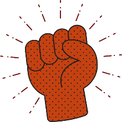 This experience is not one I am alone in. That, I know. When I think about it, this is an experience my ancestors knew all too well. In many ways, it was and still is a story of pain, state sanctioned violence, discrimination, and resilience. Stories they passed onto me through generations. These stories are alive in my body even though my mind is not always conscious of them. It is this knowledge and understanding that I try to stay connected to as much as I can. Resilience and practices of healing are something my body knows. For us, tending to wellness has not been a convenient choice but something needed in order to survive. I know the choices I make now impact the legacy of harm or healing I will eventually leave with this world. 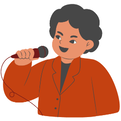 I think often about the various needs we all have when it comes to healing. Today, I looked to art to help me along my day. Political art has a history in justice movements to heal, protest and resist. The presence of political art and expression of culture is necessary in any healing centered community. The song “A Long Time Coming” by Las Cafeteras spoke to me and helped me move through what was in my body. Today, I choose to sing and dance to resist. What are you doing during these times to help you connect with your sense of resiliency? What are you doing to tend to your healing both personally and in community with others?
This is one of the first and most common questions I receive as an occupational therapist. Generally speaking, occupational therapy is a healthcare service which helps people participate functionally in the occupations or activities that are necessary or meaningful to their life. Depending on the setting or the client, those meaningful occupations can vary. For children and adolescents, one of their primary occupations is being a student. School based occupational therapy
What skills or areas can OTs help with?How does that work in distance learning?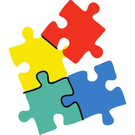 Occupational therapists adapt activities and create modifications to provide a “just right challenge” for students. This allows the student to feel successful in their schoolwork and activities while simultaneously continuing to build their skillsets. In distance learning, we continue to do just that! Instead of using sensory tools at school to self-regulate, we are building a “tool-box” of sensory items at home (i.e. blankets, squishy balls, play doh, etc.). Instead of practicing copying sentences from a real whiteboard, we are practicing copying sentences from a virtual “Zoom whiteboard.” And instead of promoting socio-emotional skills through peer interactions on the playground, we are playing turn-taking virtual games and role playing how to react and respond to what a peer said over a Zoom. For me, this has been one of the more fun challenges of virtual occupational therapy, finding games that translate easily to Zoom like Tic-Tac-Toe, Connect Four, or “Snakes.” True, the environment and resources have changed, but the service goal is the same: to help students access their curriculum in spite of any obstacles they face, including and not limited to, a pandemic. |
Authors:School Program Partnerships We're Hiring!Interested in joining our School Program Partnerships' Team? Check out our open positions below!
Categories:
All
Archives
January 2024
|

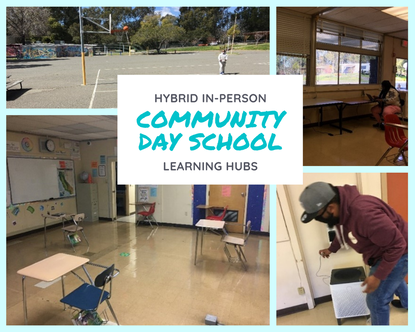




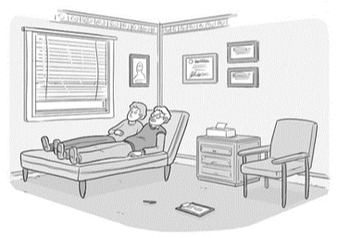
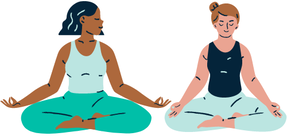
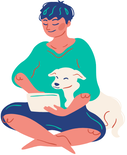

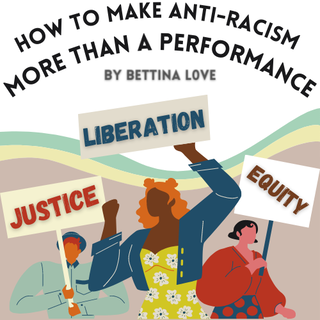

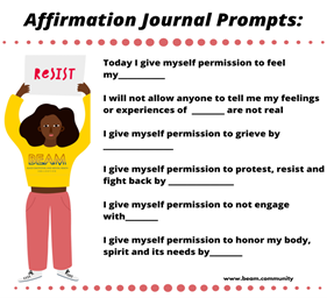
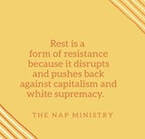
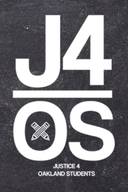


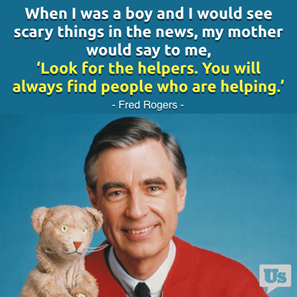





 RSS Feed
RSS Feed